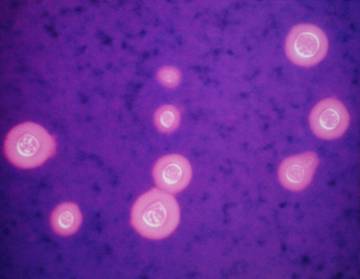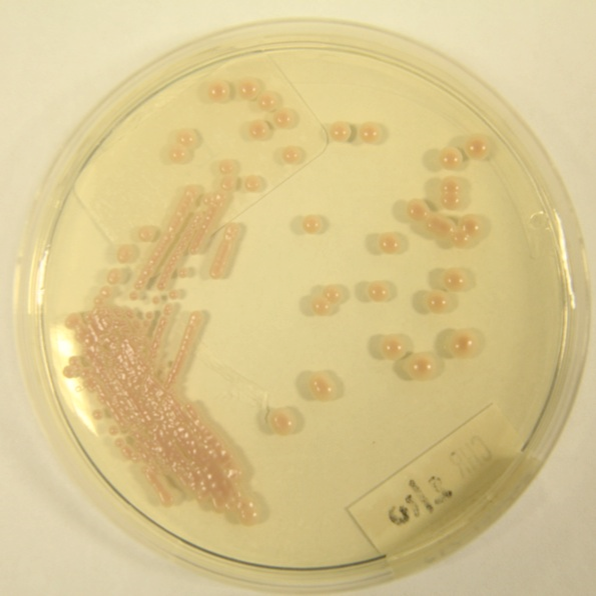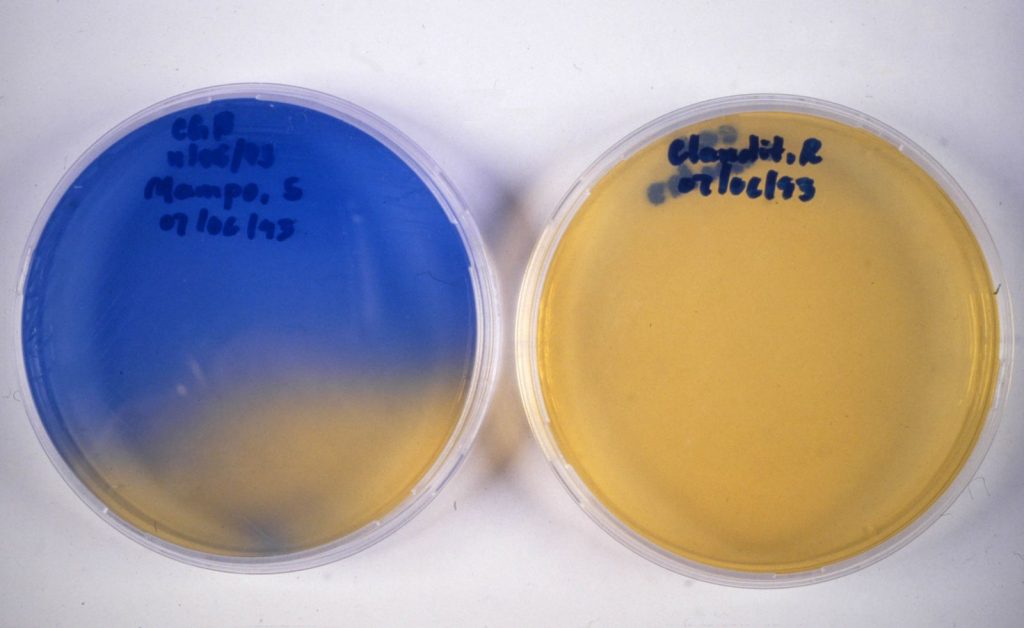Cryptococcus is best known for causing cryptococcal meningitis, especially among HIV-infected individuals, where it in an AIDS-defining disease, as reviewed by May et al (2017). Yeast cells form a thick capsule that can be visualised using India Ink, and contains glucuronoxylomannan antigen that forms the basic of the CrAg test.

Clinical lectures
Cryptococcus mycology and virulence
Epidemiology of cryptococcosis
Diagnosing cryptococcal meningitis
Cryptococcal meningitis: pathogenesis and host response
Lumbar puncture in cryptococcal meningitis
Cryptococcal IRIS
Cryptococcal meningitis: treating with antifungals
Cryptoccal meningitis: treatment outcomes
Raised intracranial pressure in cryptococcosis
Cryptococcal antigen (CrAg) testing – Biosynex CryptoPS
Interpreting CrAg titres
Cryptococcal antigen (CrAg) testing (Dynamiker lateral flow device)
CrAg FungiXpert LFA (Era Biology)
IDIM: One World One Guideline – Cryptococcosis Methods Tutorial

Factsheets
Cryptococcus neoformans
| NAMES Cryptococcus neoformans [teleomorph: Filobasidiella neoformans] |
| CLASSIFICATION Divided into: – Cryptococcus neoformans var. neoformans – Cryptococcus neoformans var. grubii. – Cryptococcus gattii used to be regarded as a third variety of C. neoformans. However, based on differences in biochemical, ecological, epidemiological and molecular characteristics, it is now recognised as a separate species. C. neoformans and C. gattii previously classified into five serotypes of C. neoformans: A, B, C, D and AD (hybrids between serotypes A and D), on the basis of antigenic differences between their capsular polysaccharides and using molecular comparison. The two varieties of C. neoformans, var. grubii and var. neoformans, are compromised of serotypes A and D respectively, while C. gattii is comprised of serotypes B and C. |
| NATURAL HABITAT Isolated most frequently from soil contaminated with pigeon and other bird droppings. Also isolated from old dried accumulations of bird droppings in buildings, but not from fresh wet droppings. The precise link between birds and C. neoformans infection remains unclear as birds are not infected but serve as a vector, spreading the fungus from vegetation throughout the environment. There is no evidence for an association between C. neoformans and specific trees, but two varieties have been isolated from decaying wood of many difference species of trees. |
| GEOGRAPHY C. neoformans serotype A accounts for about over 90% of reported human cases, found worldwide. The remaining 5% of infections are caused by C. neoformans serotype D or C. gattii serotypes B and C. Serotype D is found predominantly in European countries. |
| PREVALENCE Most common cause of meningitis in hospitals in which persons with HIV infection are treated. Incidence remains high in resource-limited settings such as sub-Saharan Africa and South East Asia. |
| DISEASES – Pulmonary – Central nervous system (meningitis and cryptococcoma) – Cutaneous – Osteomyelitis (especially in patients with sarcoidosis) – Ocular (very rare) – Asymptomatic prostate infection in HIV-negative men |
| CULTURE Pasty, smooth to mucoid, cream coloured colonies on Sabouraud dextrose agar. On malt extract agar, mucoid colonies predominate. On chromogenic agar for Candida, brownish-grey to light pink colonies. On bird seed agar, colonies are brown. Mostly spherical budding cells (3-8 mm) with a capsule visible in India ink; rarely absent. On cornmeal-Tween 80 agar, rounded budding yeast cells present only, without pseudohyphae or hyphae. Biosafety level 2 |
| ANTIFUNGAL RESISTANCE Generally susceptible to fluconazole, itraconazole, voriconazole and posaconazole but resistant to ketoconazole and miconazole. Always resistant to the echinocandins. Susceptible to amphotericin B with acquired resistance over time, if long term treatment given. Some isolates susceptible to flucytosine. Prophylaxis has potential for development of resistance to fluconazole. Optimal susceptibility testing methods not yet developed. |
| INDUSTRIAL USES None |

Left: Sabouraud slope from sputum of an AIDS patient with oral thrush showing C. albicans and C. neoformans. Right: birdseed agar showing pinpoint colonies of C. neoformans (dark brown) admixed with C. albicans (white) 
C. neoformans found in CSF, showing large capsules 
C. neoformans grown on Sabouraud

Cryptococcus gattii
| NAMES Cryptococcus gattii (formerly known as Cryptococcus neoformans var. gattii ) [teleomorph: Filobasidella bacillispora ] |
| CLASSIFICATION Subdivided into at least four different molecular types: VGI, VGII, VGIII and VGI. Geographic drivers exist for molecular types distribution. |
| NATURAL HABITAT Found mostly associated with Red Gum tree, Eucalyptus camaldulensis, and many other trees (over 50 species), e.g. other Eucalyptus spp. and Douglas Fir. Preferred ecological niche: decayed hollows and surfaces: longitudinal studies have shown that C. gattii exists in ‘hot spots’ and can transiently or permanently colonise ecological niches. Also recovered from wood products, soil, water, air, various mammals, and other sources. |
| GEOGRAPHY Frequency and diversity of molecular types varies by geography. Generally restricted to locations where the lowest winter temperature typically remains above freezing. Found mostly in tropical and subtropical areas: highly endemic in northern Australia, Papua New Guinea and SE Asia such as Malaysia. Also found in British Columbia, Pacific Northwest of USA, South America, Mexico, other part of Asia and infrequently, Europe. |
| PREVALENCE 42.8 cases of adult meningitis per million population in Central Province, Papua New Guinea. Since 1999, over 218 infections have been reported from British Columbia. Since 2004, over 90 human cases reported in US. |
| DISEASES Similar to that caused by C. neoformans, but more likely to involve non-immunocompromised patients. Infection in immunocompetent persons and development of cryptococcomas in lung and brain are far more commonly associated with C. gattii than C. neoformans. Neurological sequelae rate higher, including blindness, and more difficult to successfully treat. Surgical resection of cryptococcomas is often required. |
| CULTURE Rapid growth reaching mature colonies in 3 days. Cultures differentiated from C. neoformans and C. grubii by positive (yellow to blue) reaction on canavanine glycine bromothymol blue agar. Cells are morphologically indistinguishable from C. neoformans but in addition to round yeast cells, some more oval ones commonly form. Serodiagnostic kites or molecular tests commonly used to confirm this distinction in important cases Biosafety level 2 |
| ANTIFUNGAL RESISTANCE Generally susceptible to fluconazole, itraconazole, voriconazole and posaconazole but resistant to ketoconazole and miconazole. Azole antifungal MIC values differ among molecular types. Isolates of molecular type VGII have the highest geometric mean (GM) fluconazole MIC values (8.6 μg/mL) compared to isolates of molecular type VGI which have the lowest (1.7 μg/mL). For fluconazole, itraconazole, and voriconazole GM MIC values, VGI < VGIII < VGIV < VGII. GM MIC values for posaconazole similarly represented across molecular types, with the exception that VGII < VGIII and VGIV. C. gattii has reduced sensitivity to flucytosine. Always resistant to the echinocandins. Optimal susceptibility testing methods not yet developed. Infections require longer periods of treatment: nearly three-fold longer therapy times are required for patients with C. gattii compared with C. neoformans, due to the difficulty in reducing the size of cryptococcomas. |
| INDUSTRIAL USES None |

C. gattii (left) turns blue when grown on canavanine glycine bromothymol blue agar, unlike C. neoformans (right)

From #MedTwitter
@Crypto_Papers_ is a handy RSS feed of Cryptococcus papers from PubMed

Microscopy & pathology

